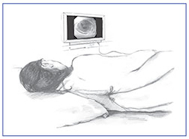This information does not constitute medical advice or replace discussion with your physician regarding you care or health concerns.
Flexible sigmoidoscopy is a test that uses a flexible, narrow tube with a light and tiny camera on one end, called a sigmoidoscope or scope, to look inside the rectum and the lower, or sigmoid colon. Flexible sigmoidoscopy can show abnormalities of the lining (mucosa) of the rectum and sigmoid colon. A health care provider performs the procedure during an office visit or at a hospital or an outpatient center.
The rectum and sigmoid colon are parts of the large intestine and represent the last parts of the GI tract. The GI tract is, a series of hollow organs joined in a long, twisting tube from the mouth to the anus—the 1-inch opening through which stool leaves the body. Organs that make up the GI tract are the mouth, esophagus, stomach, small intestine, large intestine, and anus. The last part of the GI tract—called the lower GI tract—consists of the large intestine and anus.
Reasons why a flexible sigmoidoscopy is performed include but are not limited to:
A person prepares for a flexible sigmoidoscopy by
- arthritis medications
- aspirin or medications that contain aspirin
- blood thinners
- diabetes medications
- nonsteroidal anti-inflammatory drugs such as ibuprofen or naproxen
- vitamins that contain iron or iron supplements
- cleansing the bowel. The health care provider will give written bowel prep instructions to follow at home. A health care provider orders a bowel prep so that no stool is present inside the person’s intestine.
The typical bowel preparation for a sigmoidoscopy may involve taking laxatives and enemas several hours before a flexible sigmoidoscopy. An enema involves flushing water or laxative into the rectum using a special wash bottle. Enemas can cause diarrhea, so the person should stay close to a bathroom during the bowel prep.
People should call the health care provider if there are additional questions about the preparation.
A health care provider performs a flexible sigmoidoscopy during an office visit or at a hospital or an outpatient center. and the procedure can be performed with or without sedation and takes about 20 minutes.
For the test, the person will lie on a table while the health care provider inserts a sigmoidoscope into the anus and slowly guides it through the rectum and into the sigmoid colon. The scope inflates the large intestine with air to give the health care provider a better view. The camera sends a video image of the intestinal lining to a computer screen, allowing the health care provider to examine the tissues lining the sigmoid colon and rectum. The health care provider may ask the person to move several times so he or she can adjust the scope for better viewing. Once the scope has reached the transverse colon, the health care provider withdraws it slowly while examining the lining of the colon again.
For the test, the person will lie on a table while the health care provider inserts a sigmoidoscope into the anus and slowly guides it through the rectum and into the sigmoid colon.
The health care provider can remove polyps during flexible sigmoidoscopy and send them to a lab for testing. Polyps are potential precursors of colon cancer, so removing polyps early is an effective way to prevent cancer.
The health care provider may also perform a biopsy, a procedure that involves taking a small piece of intestinal lining for examination with a microscope. The person will not feel the biopsy. A pathologist—a doctor who specializes in diagnosing diseases—will examine the tissue.
After a flexible sigmoidoscopy, a person can expect
If the gastroenterologist removed polyps or performed a biopsy, light bleeding from the anus is normal.
The risks of flexible sigmoidoscopy include but are not limited to:
Bleeding and perforation are the most common complications from sigmoidoscopy. Most cases of bleeding occur in people who have polyps removed. The gastroenterologist can treat bleeding that occurs during the sigmoidoscopy right away. However, a person may have delayed bleeding up to 2 weeks after the test. The gastroenterologist diagnoses delayed bleeding with a repeat procedure and treats it. Perforation may need to be treated with surgery.
People who have any of the following symptoms after a flexible sigmoidoscopy should seek immediate care: